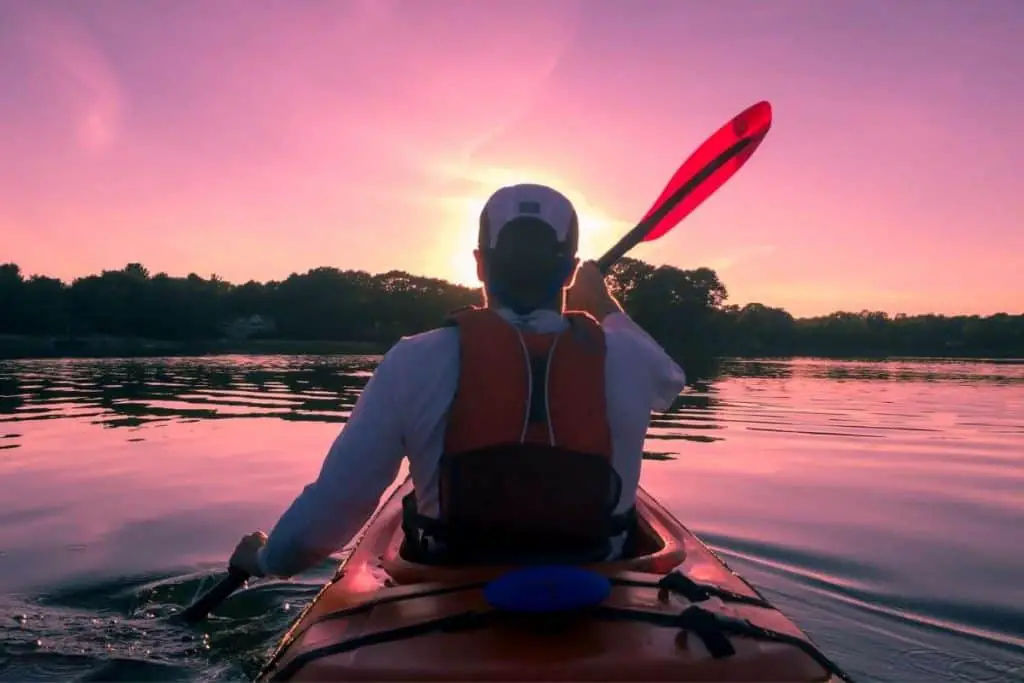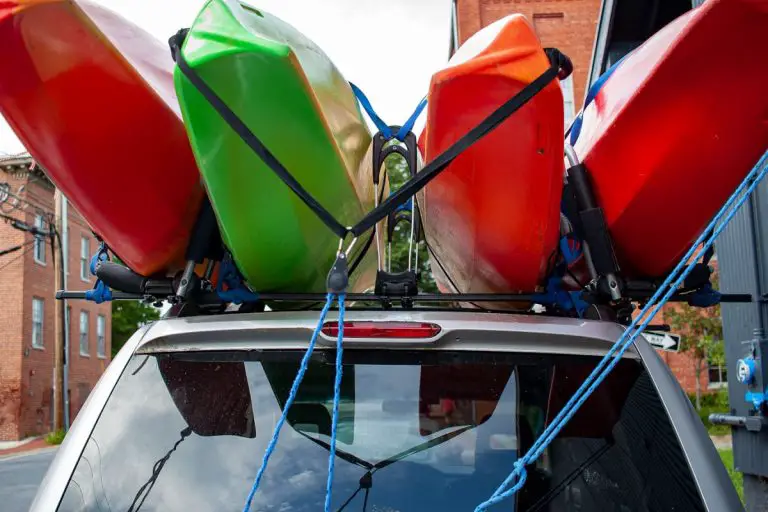Are Kayaks Considered Watercraft? (A Guide For Beginners)
Kayaks are a fun and healthy way to keep yourself in shape while having fun out on the water. The streamlined hull of the kayak is usually designed as a personal watercraft, that is one which carries a single person and is typically propelled by human power. However, tandem and larger kayaks are also available from specialty suppliers. But, are kayaks considered watercraft by definition?
Yes, kayaks are considered watercraft. By definition, watercraft are any vessel that travels on (or in) the water. Given that kayaks most definitely travel on the water, we can easily make the assertion that they are, in fact, watercraft.
Kayaks have a lot more to them than just their definition as watercraft though. We’ll take a look at the basics of kayaks within this short guide, clarifying the definition and reviewing the basic workings of this fun and exciting watercraft – the kayak.

Defining Kayaks And Watercraft
What Is A Kayak?
A kayak is a long but narrow boat that typically holds one person. A non motorized watercraft, a kayak sits low on the surface of the water and is moved by a paddle with blades on each end. The name ‘Kayak’ is believed to have originated from the small population of Inuits living on Greenland, in the Greenlandic tongue from the word qajaq.
The shape of a kayak is similar to a green bean. Both the fore and aft (front and back) of the kayak is pointed, giving the appearance that it could move as easily backwards as it could move forward. The width of a kayak at the middle where it is widest is usually under 24” making the overall vessel quite slim.
Kayaks are usually manufactured as a single rider personal watercraft but can also be found in tandem versions where two riders can ride in the kayak together. Larger specialty paddle craft are only available from certain dealers and manufacturers and typically are used by racers or rowing clubs.
Kayak Propulsion
The personal or even tandem version of the kayak is typically propelled by hand using a paddle. Unlike traditional canoe paddles, the paddle used by kayakers is a double-bladed version with a blade on either end of the paddle, foregoing a traditional grip end.
Some kayaks have a supplemental rudder that is controlled via foot pedals, lever, or rope control within the kayak. Although not a part of propulsion, this additional steering component is found on many models of kayaks available in the marketplace.
What Is A Watercraft?
We’ve defined the kayak, but what is a watercraft exactly? And how do we know for sure that a kayak fits in this definition? It’s actually a lot simpler than it may seem.
According to Wikipedia, the definition of a watercraft are ‘vehicles used in water including boats, ships, hovercraft and submarines.’ It also states that other names used for watercraft include water vessels or waterborne vessels. Both paddle craft and motorized boats or vessels can be considered watercraft.
By the above definition, it is fairly straightforward to see that kayaks, canoes, paddleboards, fishing boats, and any other craft that traverses the water, whether a personal craft or multi-person vessel, are indeed all members of the watercraft family. But, getting back to kayaks, let’s take a quick look at how they work to get an even better understanding of this particular vessel.
More About Kayaks

How Does A Kayak Work?
The typical personal kayak is usually propelled by hand. As mentioned, a double-bladed paddle is utilized. Additionally, some kayaks come with the rudder control also mentioned above. The kayak is a versatile and easily maneuvered craft that is used everywhere from lakes and rivers to white water. They are often used in the ocean as well.
Being that kayaks are commonly propelled by hand, the range of the craft is relative to the endurance of the person operating and propelling the vessel.
The rider uses both the paddle and their body to shift the kayak direction. Kayaks are very easy to turn and this makes them highly maneuverable. However, many new kayakers find it difficult to maintain control due to the ease with which the kayak will turn in the water compared to a vessel like a canoe.
Most kayakers get used to the ease of movement rather quickly which makes kayaking a fun and easy sport for most to learn. In addition, kayaks don’t typically require boat registration or a boat launch to use, making them the perfect watercraft for the occasional water enthusiast.
Safety Equipment Required For Kayaking
If you’re looking to see if a kayak is classified as a watercraft, you’re probably also wondering what kind of safety gear you’ll need to have. Fear not, there isn’t a lot of gear you’ll need in most states or provinces (depending on your country/region).
The following list is a set of equipment that will suffice to meet the minimum legal safety requirements for operating a personal watercraft. This doesn’t mean it will be legal to go kayaking in a particular body of water, you’ll need to check with local authorities to find out what is permissible.
This safety kit outlines the core basic needs for daytime kayaking in most areas. Again, check with local authorities in case the area carries supplemental requirements or regulations.
- Life Jacket or personal flotation device (Type I, II, or III U.S. Coast Guard Approved) in good working condition. Preferably reflective or bright color for easy visual location. The Onyx Curve Paddle Sports life jacket meets these requirements and is a top choice among paddlers on Amazon.com.
- Safety Whistle (Try the LuxoGear whistle with lanyard at Amazon)
- Bail-out pail or bucket (may be difficult to use in a sealed kayak). This one’s nice because it’s collapsible and takes up very little room (Amazon).
Recommended Extra Personal Protective Equipment
- Waterproof lights (continuous all-around white or flashing) like these ones (Amazon) attached on the fore and aft of the kayak. To be used in poor visibility conditions or dawn/dusk if caught out before or after full light.
- Waterproof communication devices like GPS tracking (Amazon) or cell phone. These devices can help you call for help in case of emergency but must be in a floating, waterproof container like the Pelican 1050 (Amazon).
- Although not equipment, we advise that a boating license is a wise idea for any kayaker. It may not be required in some areas to operate a personal watercraft like a kayak, but it teaches the overall rules of boating. It includes learning about things like buoys and markers, which are vital to understand if on larger waterways shared with powerboats.
Common Kayak Questions & Answers
Is a whistle required on a kayak?
Although not a legal requirement in some areas, a whistle is a cheap and effective means of getting people to hear you from a great distance. Whistles are legal requirements in some jurisdictions and are often included with a decent life jacket. For the price of a plastic whistle like a Fox 40 (Amazon), whether it’s a legal requirement or not, it is a smart piece of emergency equipment both light in weight and price.
What is the difference between a kayak and a sea kayak?
Normal kayaks and sea kayaks differ in the hull design. Sea kayaks are often considerably longer than a standard kayak. The hull is designed to be much narrower than a typical recreational kayak. Because of this the hull is less stable than a recreational kayak but tracks more effectively.
The reason why a less stable hull is required in the ocean is that it aids in the ability to maintain an upright position when dealing with rolling waves. A normal kayak, with a wider hull, will be more difficult to maneuver the hull along a wave edge that may be close to cresting.
This sort of scenario requires that a kayak be able to roll easily to maintain the correct position of the rider when on the edge of an angled wave. A recreational kayak will flip easier due to this issue when an easily rolled sea kayak will be much easier to handle on wave sides when riding near parallel to the wave crest.
In short, the hull of a sea kayak is narrower and longer than the hull of a recreational kayak. A recreational kayak will turn easier while a sea kayak will track better and go faster than a kayak meant for lakes.
How dangerous is kayaking?
Kayaks are safe and easy to use for beginners and experienced kayakers alike. Kayaking in calm water is no more dangerous than any other personal watercraft operation such as a paddleboard or canoe.
Like any water-based activity, where there is a danger of drowning, care and preventative safety measures must be taken. Using a life jacket and knowing some basic swimming and safety practices may reduce the risk exponentially.
Overall, if weather and water conditions are observed, and one stays within conditions they are comfortable and experienced with, then the level of actual danger should be relatively minimal.
Final Thoughts
Kayaking is both an exciting and athletic pastime for those who love nature, water and the outdoors. The legal requirements for using a kayak are minimal in most states and regions. Kayaking is a fun way to enjoy the great outdoors, plus it’s an easy activity to learn. You can even combine it with other hobbies like kayak fishing.
With a few moments of research into local waterways, one can quickly ascertain the legality of using a kayak in specific areas or bodies of water. And with the minimal amount of equipment required, kayaking can be something that most people will find an enjoyable activity. So, what are you waiting for? Get out on the water today!
Sources:







